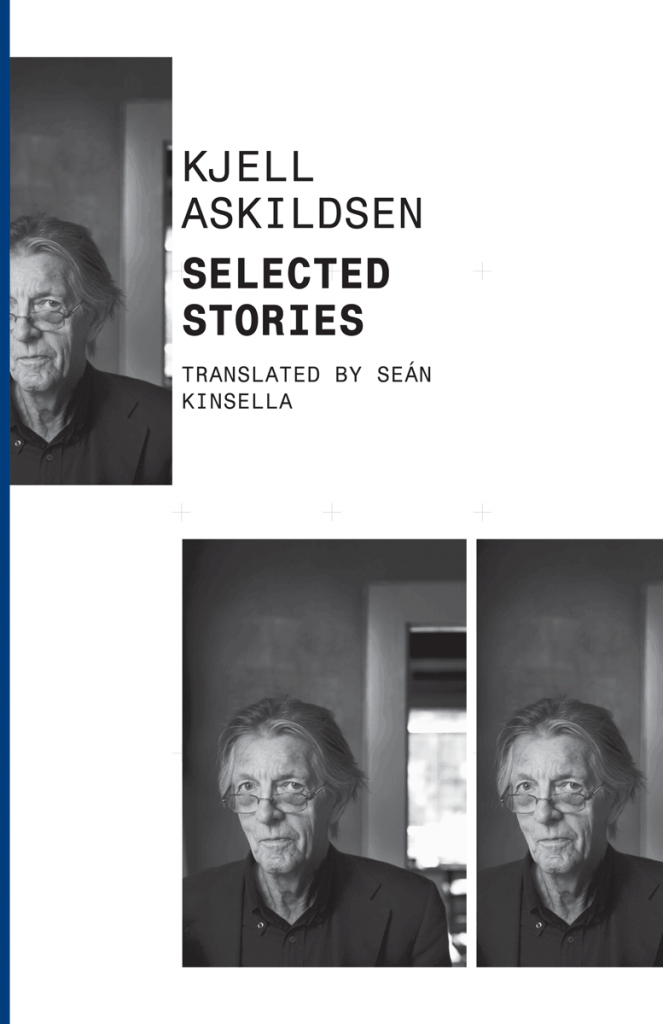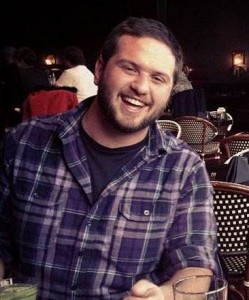Where would I have gone? one character asks. Is this question meant to illustrate his entrapment? Where would I have gone: there’s nowhere else I can go. Or is it an expression of preference? We walk a line, always, between obligation and isolation. Can you make peace with what you owe to your partner? What do you mean when you tell her, where else would I have gone? — Adam Segal
Selected Stories
Kjell Askildsen
Translated by Seán Kinsella
Dalkey Archive Press, May 2014
Paperback, 100 Pages, $11.95.
When Ameir discovered that I was a nonbeliever, he was incensed. We worked in a kitchen in downtown Iowa City; it was mid July and sweat was plentiful. What began as a jocular conversation about the benefits of certain religious dietary rules had become an expression of more radical thought: the most just society, argued Ameir, would be a total theocracy populated only by faithful adherents. He was a master provocateur, somehow believing this sincerely while simultaneously saying it simply to goad me. What about atheists, I said. They don’t belong in any society, he said. So I began to make my case.
The ensuing debate was lengthy and passionate but likely unremarkable, having been played out by young students for centuries. But one of Ameir’s more compelling barbs connected, and has stayed with me for years. If you’re so certain there’s no God to judge you, he says, and no afterlife to reward or punish you for your deeds, then why are you still here? Here, in Iowa City, in the July heat, in a restaurant kitchen. The mundane Here and not the seductive Elsewhere. His challenge presupposed questionably that the forces holding me in this Midwestern college town (close friends, need for financial stability, general contentment, crippling postgraduate uncertainty, etc.) were moral obligations as opposed to practical ones. But the challenge stung, and the challenge lingered, because in truth I’d been contemplating escape. In truth I’d been wondering just what ties were holding me in place.
This May, Dalkey Archive Press is publishing a taut little collection of fictions by the Norwegian author Kjell Askildsen. Askildsen has been writing consistently since the 1950s, though these Selected Stories have been gathered from four collections published in the ‘80s and ‘90s. Askildsen is currently in his eighties. His writing has not yet been widely translated into English.
I think of this encounter with Ameir when I think of Askildsen. Selected Stories is a meditation on individual freedom, a book fraught with the day-to-day pressures of human life.
The nine brief stories collected within can all be described in terms of absences. The absence, for example, of experimental or ornate, “flowery,” prose. The absence of unnecessary characters. The absence of exotic or alien locales, or of complicated plot arcs. The emotional landscape is barren, bleak. The stories, on first glance, exhibit such stark similarity that it’s almost alarming. The first four take place prominently in suburban gardens and on the overlooking verandas. Very few of the protagonists mention work, none of them are seen working, and only one, in the three-page “The Nail in the Cherry Tree,” has a named profession. He is a poet. Only in the opening story, “Martin Hansen’s Outing,” is a young child involved or even mentioned. Parents are aging, ailing, or freshly dead. One senses that Askildsen is delicately, deliberately seeking answers to a particular set of nagging questions, and is never quite satisfied with what he uncovers.
Askildsen’s stories are thus constrained, quiet, and at times they even feel polite. But they are not simple.
It does at first seem odd, the overwhelming lack of employment. Where, after all, is this idle world in which one’s primary concerns consist of caring for guests and tending to the vegetable patch, a world in which several stories can begin with some variation of, “We drank morning coffee in the garden”? But it is precisely in this idleness that Askildsen is able to pursue his obsessions. He is fascinated by human pettiness. His characters lie in hundreds of small ways, grow unfairly annoyed with one another, expect much and offer little. They refuse to forgive, and never apologize.
“Martin Hansen’s Outing” sees the titular protagonist lie to his wife about having to meet his brother, just so he will be able to spend his evening drinking alone on the town. Elsewhere characters pretend not to hear their wives, berate grieving relatives for not having enough ashtrays, empty bottles of wine down the drain to create the illusion they got drunker than they did, and stand around in the middle of an upstairs room, simply to “let time pass.”
These antics are variously sad, cruel, and uncomfortably relatable. But Selected Stories is not just a comedy of minor indiscretions. Martin Hansen’s lie about his brother, for example, hints at further lies, and deeper infidelity. Martin comes clean and is asked by his wife “what’s the point of all this sudden honesty?” a question that keeps him up all night, wondering, “what does she know about me that I don’t know that she knows?” Askildsen convincingly plays out the multifaceted tensions and aggressions that arise between siblings and lovers alike. These stories, with very few words, evoke whole years or even decades of family history.
The peaceful, almost pastoral setting in which these stories take place does very little to abate the characters’ strife. Askildsen avoids lingering in his descriptions of nature. In “The Dogs of Thessaloniki,” the protagonist casually takes stock of what is perhaps the collection’s most vivid depiction of Norway’s natural splendor: “I had the fjord and the distant, wooded hillsides in front of me. The murmur of hushed conversation and the gentle gurgle of the water by the shore put me in a drowsy, absentminded state.” Otherwise one gardens in order to ignore one’s family, walks in the woods as a means of hiding from one’s spouse, discusses the weather to cover up all the things one ought to say but refuses to, or can’t. “A Lovely Spot,” a story about a married couple visiting the family summer home, repeatedly employs the title phrase as a sickening joke to illustrate just how incapable the couple is of genuine communication.
—Isn’t this a lovely spot, she said.
—Certainly is, he said.
One of Askildsen’s more acute concerns in these stories is the nature of adult male sexuality, which to him contains subtle underlying elements of violence, rapaciousness, and exploitation. Martin Hansen stares out the window at his daughter’s 15-year-old friend and finds that “it wasn’t difficult” to close his eyes and picture himself “taking her.” Another character reads a “rape-like scene” in a novel, and “felt [himself] aroused.” He develops an intense sexual interest in his new sister-in-law, commenting several times on “how easy it would be to lift her up.” None of the male characters act on these darker urges. But the urges are there, contributing to the sense that the thoughts and actions bubbling up to the surface in Askildsen’s stories–the lies, evasions, and little betrayals–are just superficial manifestations of the forces really at play.
In fact the depictions of male desire reminded me often of the work of J.M. Coetzee, whose aging, overeducated protagonists are often disgusted by and at odds with the power their lust still holds over them. But where Coetzee’s protagonist philosophizes and self-interrogates, reining in the influence of his phallus as if it were an excitable beast on a chain, Martin Hansen and his compatriots are much less interested in self-study. There is very little guilt or shame to be found within these pages. Defending his curious, evasive behavior while home for his father’s funeral, Bernhard, the protagonist of “The Unseen” declares, “I can’t help the way that I am. If I were to kill a person, for instance, I couldn’t help it, but I’m not about to kill anyone, that’s not how I am. Everything that I do, I do because that’s how I am, and it’s not my fault that I’m the way that I am.” Only in “The Unseen” is this idea so explicit, but a soft fatalism envelops every one of Askildsen’s stories.
I have, on several occasions, attempted to comfort myself and close friends in the wake of a breakup with the observation that, individual human desires being as they are so fleeting and disparate, it’s really something of a miracle that any romantic relationship manages to last at all. I acknowledge that the verity of this observation, as well as its usefulness as a soothing agent, are open to debate. But it strikes me now that if youthful romance is “miraculous,” then a lifelong committed marriage must be an exercise in impossibility. Two unlike and unlikely lives, welded together by tradition, eros, child-rearing, desire for fiscal responsibility.
At very least, this might be the thought of many of Askildsen’s characters, who view marriage as a form of oppression in direct opposition to their freedom. Martin Hansen (who, it seems, makes for the perfect prototypical Askilsenian protagonist) wonders for some time just why it is he lies to his wife, and eventually lights upon the realization that “my non-disclosure and falsehoods were prerequisites for my freedom.” Another character lies about visiting his sick father in order to get away from his wife for a few hours. He, too, is attempting to reassert control over his life: “Later on, as he was driving out of town in the direction of R, he felt almost cocky, and he thought: I do as I please.”
“Do you remember the dogs of Thessaloniki,” asks the protagonist’s wife Beate in the story of the same name, “that got stuck together after they mated… All the old men outside the café shouting and screaming… and the dogs howling and struggling to get free from one another.” This unsubtle little allegory makes it clear that all parties feel equally choked by the marital bond, and also brilliantly depicts the overwhelming agitation – the howling and the struggling – hiding beneath all this small talk over coffee in the garden. But how to break free? Beate’s husband, out for a walk earlier in the story, confides: “I noticed I was reluctant to go home, and suddenly I thought, and it was a distinct thought: if only she were dead.”
What, exactly, is this sort of freedom that manifests itself in such childish, petty ways? Why is it so important to establish one’s autonomy through minor deceptions, just so that one can go smoke cigarettes down by the fjord? It turns out that marriage isn’t the real culprit. What these characters want, more than anything, is to be free of all obligations, to be owed nothing and owe nothing in return.
It’s no coincidence that friendship is almost completely missing from these stories. The closest thing any protagonist has to a friend is described as “a man my own age who lives in the area, with whom I have a somewhat forced relationship, because he once saved my life.” This same character explains to his sister that he has no girlfriend because “I prefer women who don’t make any demands of me, but who give, take, and go.” In “The Unseen,” Bernhard is shown contentedly allowing his sister and her fiancé to carry on a conversation without him: “It had grown darker, their faces weren’t completely distinct, he felt almost unseen. Almost free.”
So it’s appropriate that so many of these stories are about family visits and homecomings: the homecoming is the time when one’s current self is weighed against old expectations and aspirations, when weddings and funerals shake up or reify the accepted family dynamics. Longtime conflicts, neglected or forgotten, seethe and push against expectations of civility. In an environment of increased pressure, it’s hard not to dream of escape.
But Askildsen’s stories don’t ever build to a level of tragic, operatic family collapse. The conclusions are anticlimactic, the conflict is rarely resolved. There is generally a return, or a resignation. There is an uneasy acceptance of the fact that one is trapped in the same situation as before. “The Grasshopper,” a story of admirable subtlety and palpable sadness, ends with the husband finding his wife–with whom he has of course had some quarrel–alone and afraid in their bedroom. “I thought you had gone, she said. Where would I have gone, he said.”
Where would I have gone?
Is this question meant to illustrate his entrapment? Where would I have gone: there’s nowhere else I can go. Or is it an expression of preference?
Askildsen’s Selected Stories present a world in which one can never truly escape from one’s obligations. There is one character who gets close. His wife is dead and he is ambivalent; he speaks with her father and feels “something approaching satisfaction thinking about how, now that Helen was dead, he was no longer my father-in-law, and Helen’s sisters were no longer my in-laws either.” In all this loss of ties he seems to lose his humanity as well. Contemplating life alone on a large, empty estate, he closes his eyes and sees “that great deserted landscape, that’s painful to see, it’s far too big, and far too desolate, and in a way it’s both within me and around me.” There’s only one place we’re certain to be freed from our debt: the grave.
We walk a line, always, between obligation and isolation. Can you make peace with what you owe to your partner? What do you mean when you tell her, where else would I have gone?
— Adam Segal
.
Adam Segal is a writer and culinary professional in Portland, Oregon. He graduated from the University of Iowa some time ago, and has since interned for Graywolf Press and contributed extensively to Whole Beast Rag magazine, among myriad other adventures.


